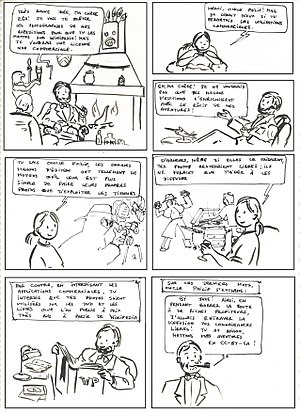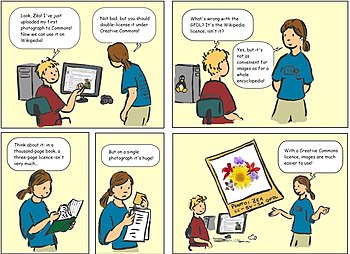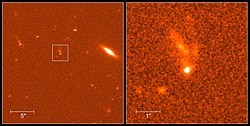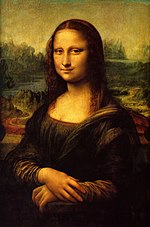Commons:Licentiëring
|
Deze pagina geeft niet-juristen een overzicht van ingewikkelde wetten op het gebied van auteursrecht door middel van instructies met voorbeelden. Het doel is om uploaders te helpen beslissen of een afbeelding of ander mediabestand aanvaardbaar is op Wikimedia Commons. Als u een hergebruiker bent op zoek naar informatie over hoe u Commons-inhoud gebruikt in uw eigen werk, zie Commons:Hergebruik van inhoud buiten Wikimedia. Wikimedia Commons accepteert alleen vrije inhoud, dat wil zeggen, afbeeldingen en andere mediabestanden die niet onder auteursrechtbeperkingen vallen, welke zouden verhinderen hen te laten gebruiken "door wie dan ook, waneer dan ook, voor welk doel dan ook". Het gebruik kan echter beperkt worden door niet aan auteursrecht gerelateerde zaken, zie Commons:Beperkingen buiten het auteursrecht, en de licentie kan om speciale maatregelen vragen. Er is ook bepaald materiaal, waarvan het auteursrecht is verlopen in het ene land, maar niet in het andere. Een aantal details worden hieronder uitgelegd. Wikimedia Commons probeert ervoor te zorgen dat zulke beperkingen vermeld zijn op de beschrijvingspagina van de afbeelding; het is echter de verantwoordelijkheid van de hergebruikers om ervoor te zorgen dat het gebruik van de media voldoet aan de licentie en geen relevante wetten schendt. Wikimedia Commons accepteert alleen media
Wikimedia Commons accepteert geen fair-use-argumenten: zie Commons:Fair use. Media alleen voor niet-commercieel gebruik bedoeld, worden ook niet geaccepteerd. De licentie die van toepassing is op een afbeelding of mediabestand moet duidelijk worden aangegeven met een auteursrechtlabel op de beschrijvingspagina van het bestand. De aangeleverde informatie moet voldoende zijn om anderen de licentie-status te kunnen laten verifiëren. Het is het beste om dit meteen tijdens het uploaden te doen. Gebruik het e-mailsjabloon voor het vragen van toestemming aan de auteursrechthebbende. |
Toegestane licenties
Met een licentie wordt bedoeld: formele toestemming waarin staat wie een auteursrechtelijk beschermd werk mag gebruiken en op welke wijze. Een licentie kan alleen worden verleend door de auteursrechthebbende. Dit is meestal de auteur (fotograaf, schilder en dergelijke).
Al het auteursrechtelijk beschermd materiaal op Commons (niet in het publiek domein) moet een vrije licentie krijgen die het eenieder specifiek en onherroepbaar toestaat om het materiaal voor welk doeleinde ook te gebruiken; het is niet voldoende dit te simpelweg te schrijven als "het materiaal kan door iedereen vrij worden gebruikt" of iets dergelijks. De licentie moet aan de volgende eisen voldoen:
- Opnieuw openbaar maken en verspreiden moeten worden toegestaan.
- Het openbaar maken van afgeleide werken moet worden toegestaan.
- Commercieel gebruik van het werk moet worden toegestaan.
- De licentie moet eeuwig (niet verlopend) en onherroepbaar zijn.
- Erkenning van alle auteurs/bijdragers van een werk mag worden vereist.
- Het onder dezelfde licentie openbaar maken van een afgeleid werk mag worden vereist.
- Voor digitale verspreiding mag het gebruik van bestandsindelingen worden vereist die vrij zijn van digitaal rechtenbeheer (ook wel bekend als DRM).
Soms wenst een auteur een afbeelding of video van een lagere kwaliteit of resolutie onder een vrije licentie vrij te geven, en tegelijkertijd strengere voorwaarden te stellen aan versies van hogere kwaliteit. Het is onduidelijk of zo een onderscheid wettelijk te handhaven is, maar het beleid van Commons is om de bedoeling van de auteursrechthebbende te respecteren door alleen de versie van lagere kwaliteit op te nemen.
The following restrictions must not apply to the image or other media file:
- Use by Wikimedia only.
- Noncommercial/Educational use only.
- Use under fair use only.
- Notification of the creator required, rather than requested, for all or for some uses.
For example, the following are generally not allowed:
- Screenshots of software that is itself not under a free license. However, screenshots of software under the GPL or a similar free software license are generally considered to be OK. See Commons:Screenshots.
- TV/DVD/Videogame screenshots. See Commons:Screenshots.
- Scans or reproductive photographs of copyrighted artwork, especially book covers, album/CD covers, etc. See Commons:Derivative works.
- Copyrighted symbols, logos, etc. (Not to be confused with trademarks.)
- Models, masks, toys, and other objects which represent a copyrighted work, such as a cartoon or movie character (rather than just a particular actor, regardless of a specific role). See Commons:Derivative works.
Commons also allows works that are not protected by copyright (i.e. works in the public domain). Please read the section about public domain below.
For an explanation of the justification for this licensing policy, see Commons:Licensing/Justifications.
Multi-licensing
You can offer as many licenses for a file as you want as long as at least one of them meets the criteria for free licenses above. For example, files may be licensed with both Creative Commons Attribution-ShareAlike (meets the criteria) and Attribution-NonCommercial. (does not meet the criteria) In this example, re-users would be given the option to create derivatives using a compatible license (ShareAlike) or use a different licensing model and be restricted to NonCommercial use. A re-user who opts for the latter may however not upload their derivative work to Commons, as Attribution-NonCommercial does not meet the criteria for a free license.
Multi-Licensing with restrictive licenses may be desirable for compatibility with the licensing scheme of other projects; also, multi-licensing allows people who create derivative work to release that work under a restrictive license only, if they wish—that is, it gives creators of derivative works more freedom with regards to which license they may use for their work. See Commons:Multi-licensing.
Well-known licenses
The following well-known licenses are preferred for materials on Commons:
- Creative Commons Attribution/Share-Alike licenses
- GNU General Public License (GPL) / GNU Lesser General Public License (LGPL)
- Free Art License/Licence Art Libre (FAL/LAL)
- Open Data Commons, for freely licensed databases where the contents are also free or available under a free license or cannot be separated from the database [1].
| Creative Commons license icons and names | Abbreviations & versions | OK here? | Notes |
|---|---|---|---|
| CC Public Domain Mark 1.0 | Often found on Flickr images, but considered problematic for use on Commons - see Public Domain section below | ||
| CC0 | |||
| CC-BY (1.0 2.0 2.5 3.0 4.0) | |||
| CC-BY-SA (1.0 2.0 2.5 3.0 4.0) | |||
| CC-BY-NC (1.0 2.0 2.5 3.0 4.0) | |||
| CC-BY-NC-ND (1.0 2.0 2.5 3.0 4.0) | |||
| CC-BY-NC-SA (1.0 2.0 2.5 3.0 4.0) | |||
| CC-BY-ND (1.0 2.0 2.5 3.0 4.0) |
- The icon
 "BY" means that the image license requires attribution, as such an image is created "BY" a certain person ("BY" is not an acronym in this case).
"BY" means that the image license requires attribution, as such an image is created "BY" a certain person ("BY" is not an acronym in this case).
 SA is for "Share Alike".
SA is for "Share Alike".
 Again, works in the public domain are also accepted (see below). See Commons:Copyright tags for more licenses.
Again, works in the public domain are also accepted (see below). See Commons:Copyright tags for more licenses.
Works which are not available under a license which meets the Definition of Free Cultural Works are explicitly not allowed. See the Wikimedia Foundation board resolution on licensing for more information.
Some examples of licensing statuses commonly found on the Internet, but forbidden on Commons, include:
 Creative Commons Non-Commercial Only (-NC) licenses
Creative Commons Non-Commercial Only (-NC) licenses Creative Commons No-Derivatives (-ND) licenses
Creative Commons No-Derivatives (-ND) licenses- Unlicensed material usable only under fair use, fair dealing, or other similar legal exceptions (see below for the reasons)
- GNU Free Documentation License (GFDL), under certain conditions (see below)
Non-permitted licenses may only be used on Commons if the work is multi-licensed under at least one permitted license.
If an image is not OK, consider asking the author to release their work under a free license such as CC-BY (Creative Commons Attribution license), or CC-BY-SA (Creative Commons Attribution Share Alike).
GNU Free Documentation License
The GNU Free Documentation License (GFDL) is not practical for most content, especially for printed media, because it requires that they be published along with the full text of the license. Thus, it is preferable to publish the work with a dual license, adding to the GFDL a license that permits use of the photo or text easily; a Creative Commons license, for example. Also, do not use the GPL and LGPL licenses as the only license for your own works if it can be avoided, as they are not really suitable for anything but software.
GFDL is not permitted as the only license where all of the following are true:
- The content was licensed on or after 15 October 2018. The licensing date is considered, not the creation or upload date.
- The content is primarily a photograph, painting, drawing, audio or video.
- The content is not a software logo, diagram or screenshot that is extracted from a GFDL software manual.
Licentie-informatie
All description pages on Commons must indicate clearly under which license the materials were published, and must contain the information required by the license (author, etc.) and should also contain information sufficient for others to verify the license status even when not required by the license itself or by copyright laws.
Specifically, the following information must be given on the description page, regardless if the license requires it or not:
- The License that applies to the material. This should be done using a copyright tag.
- The Source of the material. If the uploader is the author, this should be stated explicitly. (e.g. "Created by uploader", "Self-made", "Own work", etc.) Otherwise, please include a web link or a complete citation if possible. Note: Things like "Transferred from Wikipedia" are generally not considered a valid source unless that is where it was originally published. The primary source should be provided.
- The Author/Creator of the image or media file. For media that are considered to be in the public domain because the copyright has expired, the date of death of the author may also be crucial (see the section about public domain material below). A generic license template which implies that the uploader is the copyright holder (e.g. {{PD-self}}) is no substitution for this requirement. The only exceptions to this is if the author wishes to remain anonymous or in certain cases where the author is unknown but enough information exists to show the work is truly in the public domain (such as the date of creation/publication).
Of less importance, but should always be provided if possible:
- The Description of the image or media file. What is it of? How was it created?
- The Date and place of creation. For media that are considered to be in the public domain because the copyright has expired, the date of creation may be crucial (see the section about public domain material below).
These points of the description can be done at best using the Information template. For usage of this template see Commons:First steps/Quality and description.
Scope of licensing
In some cases, a document (media file) may have multiple aspects that can and have to be licensed: Every person that contributed a critical part of the work has rights to the results, and all have to make their contribution available under a free license—see derivative work. However, the distinctions are unclear and may differ from country to country. Here are a few examples to clarify:
- For a music recording, the following aspects must be taken into account, and each must be under a free license (or in the public domain):
- The score of the music (rights by the composer)
- The lyrics of the song (rights by the writer)
- The performance (rights by the performers)
- The recording (rights by the technical personnel / recording company)
- For a picture of artwork (also book covers and the like), it is similar:
- The creator of the original artwork has rights to any reproductions and derivative work.
- The photographer has rights to the image, if it is not a plain reproduction of the original.
- For a picture of a building, note that the architect may hold some rights if distinct architectural features are shown, but see also Commons:Freedom of panorama.
This is often problematic, if the artwork is not the primary content of the image or is not clearly recognizable: in that case, usually only the creator of the resulting picture (recording, etc.) holds a copyright. For instance, when taking a photograph of a group of people in a museum, the photo may also show some paintings on the walls. In that case the copyright of those paintings does not have to be taken into account. The distinction however is not very clear. The Commons:De minimis policy has more information about this concept.
Note that the license for all aspects has to be determined and mentioned explicitly. Also note that most reproductions do not allow the person doing the reproduction to claim a new copyright; the creator of a digital image/ reproduction of a picture owns no new copyright to the resulting digital image. The only relevant copyright is that of the original picture. This also applies to Screenshots.
Materiaal in het publiek domein
Material released under a license like CC-0 is considered the equivalent of public domain material; works that lack originality and edicts are in the public domain; a few governments around the world, including the US Federal, California, and Florida governments place most of their works, including most of their public records in the public domain; the English Wikipedia's guideline on public domain material more precisely defines these many exceptions.
Commons staat materiaal toe die in hetpubliek domein is. Dit zijn documenten die niet in aanmerking voor het auteursrecht of waarvan het auteursrecht is verlopen. Het "publieke domein" is ingewikkeld; auteursrechtenwetten verschillen per land, en daarom kan bijvoorbeeld een werk in het ene land in het publieke domein zijn en kan er in het andere land auteursrechten rusten op het werk. Er zijn internationale verdragen zoals de Conventie van Bern die minimumnormen probeert vast te stellen. Individuele landen zijn vrij om onder deze norm te gaan. Een algemene vuistregel is dat als de maker van het werk als minstens 70 jaar dood is, zijn/haar werk in het publieke domein zijn in het land waar de maker burger was en in het land waar het werk als eerst was gepubliceerd. Als het werk anoniem is of een gezamenlijk werk (bijvoorbeeld een encyclopedie), is het meestal in het publieke domein 70 jaar na de datum van de eerste publicatie.
Many countries use such a copyright term of 70 years. A notable exception is the U.S. Due to historical circumstances, the United States has more complex rules:
- Works published before 1925 are in the public domain.
- For works first published before 1964, copyright lasts 28 years after publication (and is therefore currently expired) unless the owner filed for renewal (during the window between 27 and 28 years after publication) in which case rights were extended to 95 years after first publication—the large majority of works published before 1964 have passed into the public domain, but it is imperative to determine that copyright was not renewed (which can be done through an online search at the Copyright Office for works published since 1951)
- For works first published before 1978: until 95 years after the first publication
- For works first published 1978 or later: until 70 years after the author's death. Anonymous works or work made for hire: until the shorter of 95 years since the first publication or 120 years since the creation of the work
For works created before 1978 but only published 1978 or later, there are some special rules. These terms apply in the U.S. also for foreign works.
However, the year and location of publication is essential. In several countries, material published before a certain year is in the public domain. In the U.S. this date is January 1, 1925. In some countries, all government-published material is public domain, while in others governments claim some copyright (see Commons:Copyright rules by territory).
In the US, the copyright situation for sound recordings (including those published before 1925) is a special case. Under Title II of the Music Modernization Act, recordings that were first fixed prior to February 15, 1972 are copyrighted for a period of time under US federal copyright that depends on when the recording was first published. This federal copyright applies regardless of any formalities (copyright notice, registration, and/or renewal.) The specific copyright term lengths are as follows:
- Recordings that were first published prior to 1923 will enter the public domain on January 1, 2022.
- Recordings that were first published between 1923 and 1946 are copyrighted for a period of 100 years after first publication.
- Recordings that were first published between 1947 and 1956 are copyrighted for a period of 110 years after first publication.
- Recordings that were published after 1956 and first fixed prior to February 15, 1972 will enter the public domain on February 15, 2067.
Sound recordings that were first fixed on or after February 15, 1972 are subject to the same US copyright law term lengths and provisions as other works.
In some jurisdictions (like the United States), one can also explicitly donate work one has created oneself to the public domain. In other places (like the European Union) this is technically not possible; instead, one can grant the right to use the picture freely with, for example, the Creative Commons Zero Waiver, which waives all rights granted by copyright, but the waiver might not be legally binding in the full extent of what is normally understood as “public domain” (e.g. regarding authors' moral rights).
The Hirtle chart is a tool for helping to determine if something is in the public domain in the United States. Commons:International copyright quick reference guide helps to determine if a work first published outside the United States can be uploaded.
Interaction of US and non-US copyright law
Commons is an international project, but its servers are located in the U.S., and its content should be maximally reusable. Uploads of non-U.S. works are normally allowed only if the work is either in the public domain or covered by a valid free license in both the U.S. and the country of origin of the work. The "country of origin" of a work is generally the country where the work was first published.
When uploading material from a country outside the U.S., the copyright laws of that country and the U.S. normally apply. If material that has been saved from a third-party website is uploaded to Commons, the copyright laws of the U.S., the country of residence of the uploader, and the country of location of the web servers of the website apply. Thus, any licence to use the material should apply in all relevant jurisdictions; if the material is in the public domain, it must normally be in the public domain in all these jurisdictions (plus in the country of origin of the work) for it to be allowable on Commons.
For example, if a person in the UK uploads a picture that has been saved off a French website to the Commons server, the uploader must be covered by UK, French and US copyright law. For that person to upload that photograph to Commons, the photograph must be public domain in France, the UK and the US, or there must be an acceptable copyright license for the photograph that covers the UK, US and France.
Exception: Faithful reproductions of two-dimensional works of art, such as paintings, which are in the public domain are an exception to this rule. In July 2008, following a statement clarifying WMF policy, Commons voted to the effect that all such photographs are accepted as public domain regardless of country of origin, and tagged with a warning. For details, see Commons:When to use the PD-Art tag.
Uruguay Round Agreements Act
- Main page: Commons:URAA-restored copyrights
The Uruguay Round Agreements Act or URAA is a US law that restored copyrights in the U.S. on foreign works if that work was still copyrighted in the foreign source country on the URAA date. This URAA date was January 1, 1996 for most countries. This means that foreign works became copyrighted in the U.S. even if they had been in the public domain in the U.S. before the URAA date. See also Wikipedia:Non-U.S. copyrights.
Because the constitutionality of this law was challenged in court, Commons initially permitted users to upload images that would have been public domain in the U.S. without the URAA. However, the constitutionality of the URAA was upheld by the U.S. Supreme Court in Golan v. Holder. After discussion, it was determined that the affected files would not be deleted en masse but reviewed individually. There was further discussion about the best method for review of affected files, resulting in the creation of Commons:WikiProject Public Domain.
Files affected by the URAA should be tagged with {{Not-PD-US-URAA}}.
Files nominated for deletion due to the URAA should be evaluated carefully, as should be their copyright status under US and local laws. A mere allegation that the URAA applies to a file cannot be the sole reason for deletion. If the end result of copyright evaluation is that there is significant doubt about the freedom of a file under US or local law, the file must be deleted in line with the precautionary principle.
PD 1.0 and Flickr
![]() The Creative Commons Public Domain 1.0 mark (PDM) is often applied to images on photography websites such as Flickr.com, and is not a license. This mark is considered problematic and it is not suitable for use on Commons. For further information, see the discussion Flickr and PD images - Status of PD Mark 1.0.
The Creative Commons Public Domain 1.0 mark (PDM) is often applied to images on photography websites such as Flickr.com, and is not a license. This mark is considered problematic and it is not suitable for use on Commons. For further information, see the discussion Flickr and PD images - Status of PD Mark 1.0.
Fair use is not allowed on Commons
Wikimedia Commons does not accept content under the condition of fair use. See Commons:Fair use.
Derivative works

You want a picture of Mickey Mouse, but of course you can't just scan it in. Why not take a picture of a little action figure and then upload it? Don't. The reason why you can't upload photographs of such figures is that they are considered as derivative works. Such works can't be published without permission of the original creator.
The US Copyright Act of 1976, Section 101, says: "A derivative work is a work based upon one or more preexisting works, such as a translation, musical arrangement, dramatization, fictionalization, motion picture version, sound recording, art reproduction, abridgment, condensation, or any other form in which a work may be recast, transformed, or adapted. A work consisting of editorial revisions, annotations, elaborations, or other modifications which, as a whole, represent an original work of authorship, is a “derivative work”." A photograph of a copyrighted item is considered a derivative work in US jurisdiction. US Copyright Act of 1976, Section 106: "(...) The owner of copyright under this title has the exclusive rights to do and to authorize any of the following: (...) (2) to prepare derivative works based upon the copyrighted work;"
Therefore, "unauthorized" derivative works, like photographs of copyrighted action figures, toys, etc., must be deleted. For more information, see Commons:Derivative works.
Exception: So-called useful articles - objects with an intrinsic utilitarian function, even if commercial designs, are not subject to copyright protection in the US. Consequently, images thereof are not derivative works under US law. For details and applicability of this exception, see the Supreme Court’s decision in Mazer v. Stein, and {{Useful-object-US}}.
Simpel ontwerp
Regarding trademarks (see also Commons:Copyright rules by subject matter: Trademarks): Most commercial items and products are protected by intellectual property laws in one way or another, but copyright is only one such protection. It is important to make the distinction between copyright, trademarks, and patents. Wikimedia Commons generally only enforces copyright restrictions, for these reasons:
- Almost anything can be trademarked, and it wouldn't make sense to forbid everything.
- Trademarks and industrial designs restrictions are pertinent to industrial reproduction, but photographs of such items can otherwise be freely reproduced.
→ For these reasons Commons accepts any trademark whose copyright has expired. Moreover, Commons accepts images of text in a general typeface and of simple geometric shapes, even if it happens to be a recent trademarked logo, on the grounds that such an image is not sufficiently creative to attract copyright protection.[1] Such images should be tagged with {{PD-ineligible}} or one of the list of more specific tags for this kind of works (e.g. {{PD-textlogo}} for simple logos).
Raster renderings (i.e. PNG images) of uncopyrighted simple designs can themselves be regarded as being uncopyrighted. For vector images (i.e. SVG files) of uncopyrighted simple designs, the question as to whether the vector representation has its own copyright is less clear; see the English Wikipedia copyright information about fonts and the {{PD-textlogo}} talk page for more information.
It is often very difficult to determine whether a design is protected by copyright or not, and images of these sorts are frequently nominated for deletion, with various results. See Commons:Threshold of originality and/or “Threshold of originality” (in Wikipedia) for some guidance.
Lettertypen
The raster rendering of a font (or typeface) is not subject to copyright in the U.S., and therefore is in the public domain. It may be copyrighted in other countries (see intellectual property of typefaces on Wikipedia). You should use {{PD-font}} in this case.
Auteursrechtelijke regels
Some guidance on applicable copyright rules can be found at
- Commons:Copyright rules by territory
- Commons:Copyright rules by subject matter (formerly "Commons:Image casebook")
See also
See also
- Copyright tags
- Copyright FAQ for English Wikipedia
- Help:Public domain
- Open Content - A Practical Guide to Using Creative Commons Licences (also available as PDF, ISBN 978-3-940785-57-2)
- Stock.xchng Policy
- Commons:WikiProject Permission requests
- Commons:Choosing a license
Opmerkingen
- ↑ See Ets-Hokin v. Skyy Spirits Inc where it was decided that the SKYY vodka bottle and logo were not copyrightable
Externe links
Collections of laws:
- UNESCO collection of copyright laws.
- WIPO Lex.
- CERLALC: Copyright laws of Latin America, the Caribbean states, and Spain and Portugal.
- CIPR: Copyright laws of the CIS nations and the three Baltic states.
- ECAP: Copyright laws of ASEAN countries.
- EuroMed Audiovisual II EU programme; has recent copyright laws of some mediterranean states (from Morocco to Turkey).
Copyright treaties:
- Berne Convention.
- WIPO Copyright treaty.
- EU Council Directive 93/98/EEC on the harmonization of copyright terms in the EU.
Other:
- Circular 38a: International Copyright Relations of the United States, from the U.S. Copyright Office. (A bit dated, some countries are missing.)
- Circular 38b: Highlights of Copyright Amendments Contained in the URAA, from the U.S. Copyright Office.
- 17 USC 104A: Copyright restorations in the U.S. due to the URAA
- Copyright in the USA





